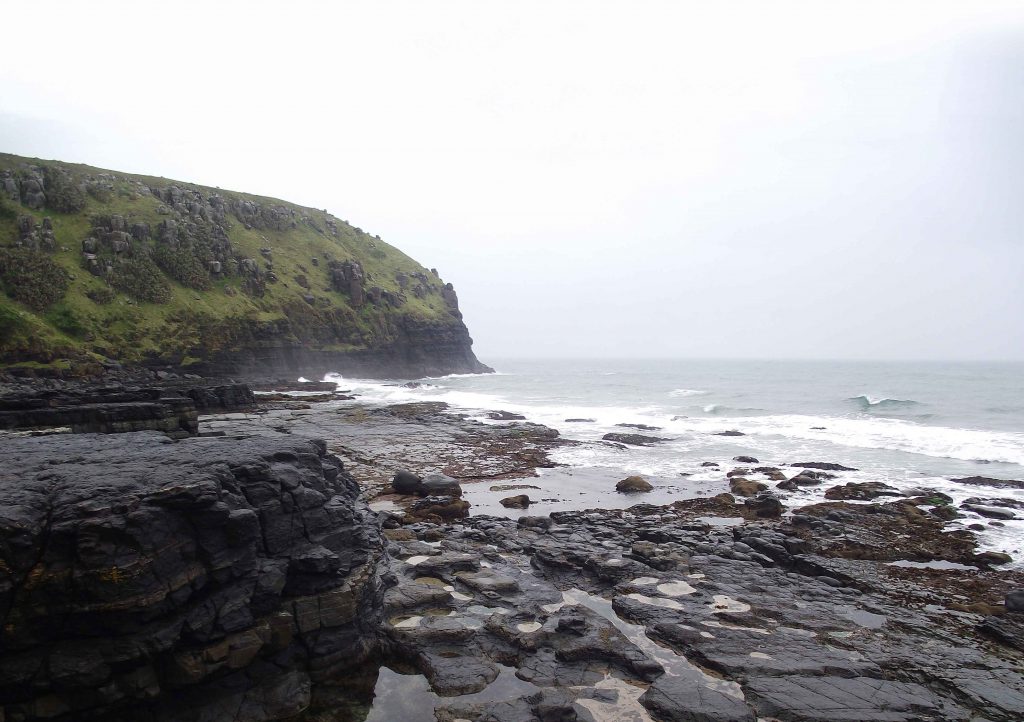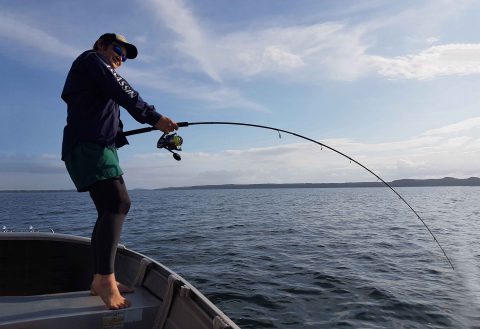Rock Surf & Deep
Embraced By Nature’s True Treasures
Located 90km from East London and 5km west of the hamlet of Morgan Bay, anglers will find Double Mouth, a true gem of nature. Double Mouth ranks as one of the flagships of the Eastern Cape Parks and Tourism Agency’s nature reserves. It is one of 10 coastal reserves within the extensive East London Coast Nature Reserve. And yes, sustainable, responsible fishing is permitted subject to the possession of an angling licence. This popular campsite offers 30 caravan or tent sites with electricity. The upgraded ablution facilities ensure plenty of hot water and comforts.
Fishermen, both local and upcountry enthusiasts, return regularly once they have savoured the spectacular natural beauty and the fishing prospects of the area. What makes Double Mouth so appealing to the angler is the vastness of fishing options that it provides. It is an ideal base from which anglers can walk to Black Rock across Bead Beach in pursuit of numerous species.
Black Rock with its deep water and the adjoining rocky surf zone with its appealing gullies right up to the sandy Bead Beach are renowned for catches of kob, with the latter caught regularly off this beach, particularly at night.
The gullies and “holes” between Bead Beach and Black Rock have become increasingly popular with dropshot enthusiasts who can often be seen waist-deep in the water working the gullies on an incoming tide. This zone is pristine and consequently produces good yields not only of kob but also blue fish (bronze bream), silver steenbras (musselcracker) and the odd black steenbras (poenskop). Blacktail remain omnipresent throughout the year. Floating pieces of kelp can be a nuisance, however, especially after a spell of heavy seas.
The area in front of the campsite is arguably the most popular fishing area, mainly, I suspect, because of its close proximity to the caravans and tents. During the peak December and Easter periods many anglers will amble down to those rocks in the evenings and early mornings hoping to impress loved ones with a delectable free meal. Bronze bream and other pan fish constitute the main catch in this area. I have however seen anglers encounter adrenaline-invoking “pulls” there only to end up with an excitement-draining moment when they discover that their hoped-for prize fish was only a frisky gulley shark!
Left of the campsite and into the bowels of the bay leading up to the Morgan Bay cliffs, anglers will find one of the most exciting fishing zones along the Wild Coast. This area has dramatic natural features with high rocks, flat rocks and deep interspersed gullies – but this is its allure. This area is not for the faint-hearted. It requires a good measure of physical fitness to move along this zone, especially for the return trip to the campsite. This area up to what is often referred to as Botha’s Krantz provides some of the most aggressive fishing in the area. It is the ideal place for the Rambo angler who is skilled and capable of managing the pitbulls of the ocean bed.
Heavy tackle, especially end traces, need to be robust in order to contend with sharks (raggies mainly, especially after spells of east wind have chilled and soiled the water). Huge spotted gulley sharks and duckbill rays also provide adrenaline rushes. Big black steenbras conclude the premier league. Good fillet bait almost guarantees success.
Don’t dawdle after you have dispatched a fresh blood-oozing sliced fillet bait into the sea. Brace yourself instead for an imminent brutal encounter, otherwise you may need the services of a physio! Once a big hook-up has occurred, you need to have patience. Landing those monsters will take time and skill as the angler has to endeavour to coax the beauts into the small bays or gullies for landing.
Sadly I don’t have the muscles or physical stature to be classified as a Rambo angler, yet I still prefer fishing this area of Double Mouth. You never know your luck in the Big City when fishing there. Closer in blacktail, bronze bream and small black steenbras are caught in the gullies. This area is, however, a great consumer of sinkers and traces. If there is drifting seaweed in the water don’t linger as your blood pressure is likely to rise.
The name “Double Mouth” is somewhat of a misnomer as it may suggest that there are two outlets to the sea. The name in fact relates to the confluence of two rivers, namely the Quko and Mqotwane rivers which converge just before flowing into the sea. Of the two rivers, the Quko has the most impressive estuary. A part of Double Mouth’s allure comes from this feature, which is heaven on Earth for the fly fisherman and the estuary enthusiast.
They have a good choice of target fish to pursue. It is a clean, healthy and relatively undisturbed estuary that attracts an array of aquatic and other birds, is home to the clawless otter, a haven for juvenile fish and a reserve for plentiful mullets. I have seen blue duiker and bushbuck grazing on its perimeter. It would be hard to visualise a more tranquil setting for parents to introduce their children to the privileged pastime of angling. Possibly that regal bird of the estuaries, the fish eagle, has marked its territory. I am hoping to hear its call soon. A light, portable river craft would maximise a fishing experience there.
What makes Double Mouth so special is the historical context in which anglers can enjoy their indulgence. Bead Beach, the white sandy beach adjoining the mouth of the river on the western side, was a refuge for Portuguese survivors of the ill-fated Santa Espiritu which was wrecked in the area in 1608. Next time you fish from that beach, think of those survivors who used the space, very much in Robinson Crusoe fashion, to construct a makeshift craft from salvaged parts of the Santa Espiritu. It is claimed that the survivors managed to save themselves by sailing off to Mozambique in their reconstructed vessel.
While fishing from the beach, also be on the lookout for cowrie shells, Carnelian beads and blue and white Chinese Ming porcelain shards which the tides have generously deposited on the shore. They emanate from the sunken Santa Espiritu and have washed up onto the shore over the past 400 years. They are still being discovered. Also bear in mind that the Double Mouth shore was at one stage in our history home to the Late Stone Age inhabitants who would forage and trap fish along this stretch of coastline. Thank goodness they were conservative in habit and didn’t have access to dropshot tackle.
Double Mouth provides the added convenience of being a good base from which to fish the surrounding areas, especially the many exciting spots that Morgan Bay and Kei Mouth offer. The area west of the Kei River Mouth in line with the Inniskilling Rocks is an excellent place for kob, white steenbras (pignose) and a variety of non-edibles. The chocolate-brown water that periodically washes out to sea from the Kei River doesn’t seem to discourage the cob from entertaining choice bait. I have witnessed some good-size musselcracker being landed there, albeit in cleaner water during times of prevailing westerly winds.
The Ducks Pond and Lighthouse areas between Kei Mouth and Morgan Bay will entertain the serious angler all day. Shad abound during the mid-winter months, especially at Ducks Pond. Serious shark angling into deep water is offered from the bold rocks between Ducks Pond and the beach at Morgan Bay. Anglers need to ensure that their tackle is up to the task if they wish to pose for a photograph next to the one that didn’t get away.
There is a wide choice of accommodation for the angler visiting this area, with options likely to meet most budgets. There are two hotels in Morgan Bay, holiday homes to rent, B&Bs and caravan parks (Morgan Bay and Kei Mouth) that allow for different comfort and facility requirements. Anglers need only Google “Kei Mouth” and “Morgan Bay”.
I always opt to stay at Double Mouth campsite because of my love for nature and the great outdoors. The more rustic the camping environment, the happier I am – but that is not everyone’s taste.
The majestic natural beauty of Double Mouth is a balm for the soul, a mood lifter and a retarder of age. Put it on your fishing bucket list as this place offers the ultimate therapy.






 Sign-up and receive the Business Media MAGS newsletter OR SA Mining newsletter straight to your inbox.
Sign-up and receive the Business Media MAGS newsletter OR SA Mining newsletter straight to your inbox.